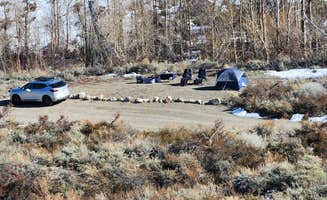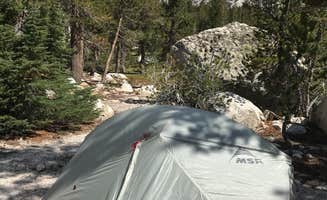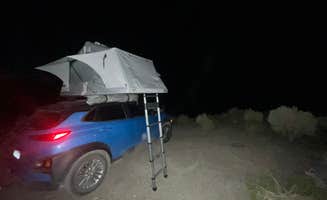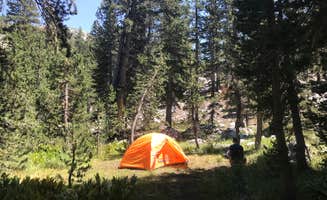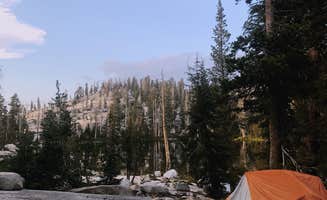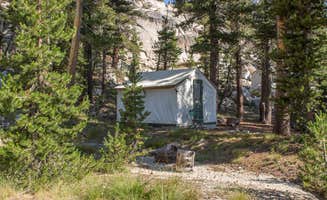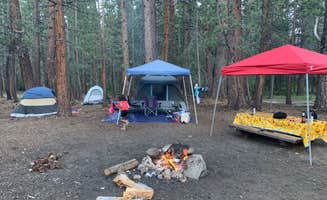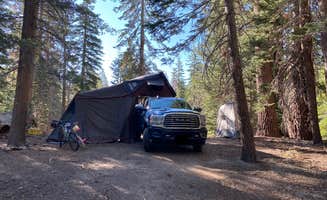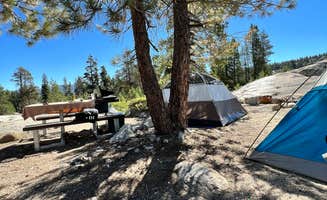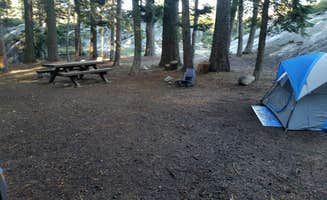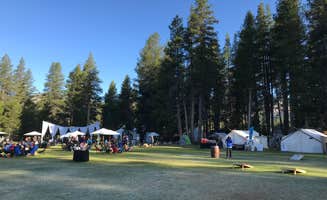Dispersed tent camping near Bridgeport, California ranges from volcanic landscapes at 8,000+ feet elevation to alpine meadows with creek access. The Eastern Sierra region experiences dramatic temperature shifts, with summer days reaching 80°F and nights dropping to near freezing even in July. Volcanic soil conditions in many areas create unique challenges for tent staking, especially during the frequent afternoon wind patterns common to the region.
What to do
Fishing at pristine alpine lakes: Virginia Lakes, accessible from Upper Virginia Creek Campground, offers excellent trout fishing opportunities. "Virginia lakes resort is a 5 minute drive. Bodie ghost town and Mono lake are great day adventures from here as well," notes Bruce E.
Hiking to mountain viewpoints: Trek the high-altitude trails near Lake Helen Dispersed Campsites for panoramic views of the Eastern Sierra range and Mono Basin. The network of trails ranges from gentle meadow walks to challenging summit climbs above 10,000 feet.
Backcountry exploration: Venture deeper into Yosemite territory via the Glen Aulin High Sierra Camp trail system. "Great starting point to do day hikes into the Grand Canyon of the Tuolumne," says Daniel L. The 6-mile hike from Tuolumne Meadows leads to beautiful alpine terrain.
Wildlife observation: Early mornings at Mill Creek provide opportunities to spot mule deer, ground squirrels, and various bird species. The meadow areas near creeks are particularly active with wildlife at dawn and dusk.
What campers like
Solitude and separation: At Mono Basin Dispersed Camp Site, campers appreciate the privacy between sites. "We found a nice, open campsite with great views of Mono Lake and the eastern Sierras," reports Emma T. Most sites allow for proper distancing from neighbors.
Creek-side relaxation: The soothing sounds of running water enhance the camping experience at many sites. "Cool water, a nice breeze in the evening, water sounds day and night. Quiet," shares DJ M. about camping along Mill Creek.
Night sky viewing: The minimal light pollution creates exceptional stargazing conditions. "Overlooking mono lake on one side and a mountain range on the other," describes Jaden J. The volcanic terrain provides natural platforms for unobstructed celestial observation.
Geological features: The unique formations around Mono Lake create an otherworldly landscape for exploration and photography. The volcanic composition of the soil and surrounding terrain provides a distinctive camping backdrop not found in other Sierra locations.
What you should know
Road conditions and vehicle requirements: Many dispersed sites require careful navigation. "Road got quite sandy in some sections, would recommend having a 4x4 to access some of the sites," advises Emma T. about Upper Lyell Canyon Footbridge Backcountry Campsite. However, standard vehicles can reach some areas with caution.
Temperature fluctuations: Be prepared for significant day-to-night temperature changes. "It gets warm during the day, but there is a good breeze during the day. And an even better breeze at night," notes Val C. about camping in July. Nighttime temperatures commonly drop below 40°F even in summer.
Water sources and filtration: Most dispersed sites require water filtration from nearby creeks. "The Tuolumne River was our water source, which is located adjacent to the camp," shares Erin S. Seasonal flow variations can affect reliability, particularly in late summer.
Insect preparation: Bug activity intensifies near water sources and during certain seasons. "Lots of bugs. bring bug spray," warns Val C. Evening mosquito activity can be particularly heavy in meadow areas and near creeks.
Tips for camping with families
Established sites for easier logistics: Choose locations with basic amenities for family comfort. "For a free spot, it was clean and had pit toilets, bear boxes and fire pits," says Bruce E. about Upper Virginia Creek Campground, making it suitable for families with younger children.
Wildlife education opportunities: The diverse ecosystems provide natural learning experiences. Young campers can observe pika, marmots, and various bird species in their natural habitat, particularly at higher elevation sites.
Creek exploration for children: Shallow creek areas offer safe water play opportunities during warmer months. "Nice shaded with creek sounds," mentions Kristin C., describing the Mill Creek area that provides natural entertainment for children.
Gradual acclimatization: When camping at higher elevations with children, Young Lakes Backcountry Camp visitors recommend spending a night at mid-elevation first. "Great backcountry campsite with a ~6.4 mile hike in," notes Esther Y., suggesting families should prepare properly for the elevation gain.
Tips from RVers
Limited RV access at most sites: Most dispersed camping areas near Bridgeport have significant access limitations for larger vehicles. Small trailers and campervans can navigate to some areas, but full-sized RVs should seek established campgrounds.
Leveling challenges on volcanic terrain: The uneven ground at many dispersed sites requires additional leveling equipment. The sandy volcanic soil can shift under stabilizers, especially after rain.
Alternative dispersed options: For those with smaller RVs or campervans, Hardin Flat Road provides accessible options. "I am parked across from a private drive so I can turn around with my RV if needed," shares Ashley M. about finding suitable parking for smaller rigs.
Seasonal planning for RV access: Spring snowmelt creates muddy conditions on many forest service roads. "Went on 4/5/24 - 4/7/24. I stayed to car camp and had an overall nice time. There was a good amount of ice but with 4x4 not problem," reports Martin A., noting challenging early season conditions.


